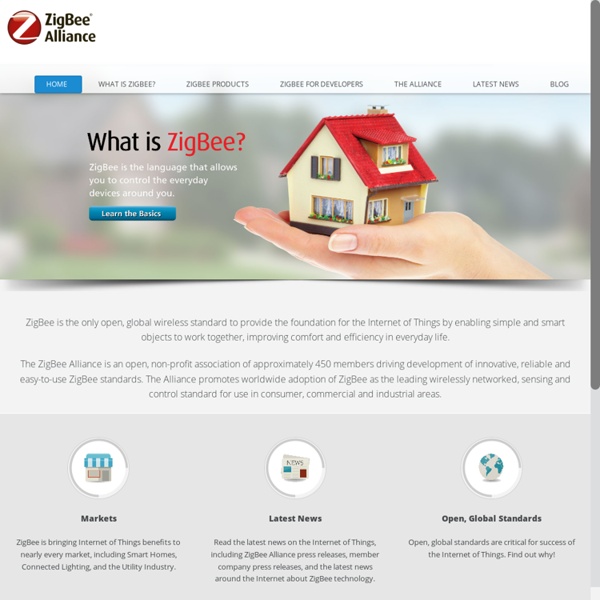



Macintosh Home Automation and Control Server Bluetooth <div id="ctl00_g_e5f15daa_2b01_45cc_a24d_46a1340b4977_noscript">It looks like your browser does not have JavaScript enabled. Please turn on JavaScript and try again.</div> English La domotique chez Benchi Suite à mon intégration dans le groupe HoMiDom, j’ai décidé d’utiliser le protocole ZCL (Zigbee Cluster Library) pour mon application sur Arduino. Je travaille donc depuis sur le développement du driver ZigBee pour HoMiDom et le programme Arduino en ZigBee. N’étant pas un excellent anglophone ;) je traduit et interprète les spécifications Zigbee Cluster Library au fil de l’eau. Cet article est donc mon bloc note ZigBee ZCL !
XBee XBee is the brand name from Digi International for a family of form factor compatible radio modules. The first XBee radios were introduced under the MaxStream brand in 2005[2] and were based on the 802.15.4-2003 standard designed for point-to-point and star communications at over-the-air baud rates of 250 kbit/s.[3] Two models were initially introduced—a lower cost 1 mW XBee and the higher power 100 mW XBee-PRO.[4] Since the initial introduction, a number of new XBee radios have been introduced and all XBees are now marketed and sold under the Digi brand. As of February 2013, the XBee radio family consists of[7] Form-factors, antennas, and data modes[edit] A pair of XBee radios (through-hole with the wire whip antenna type).
6LoWPAN 6LoWPAN is an acronym of IPv6 over Low power Wireless Personal Area Networks.[1] 6LoWPAN is the name of a concluded working group in the Internet area of the IETF.[2] The 6LoWPAN concept originated from the idea that "the Internet Protocol could and should be applied even to the smallest devices,"[3] and that low-power devices with limited processing capabilities should be able to participate in the Internet of Things.[4] The 6LoWPAN group has defined encapsulation and header compression mechanisms that allow IPv6 packets to be sent to and received from over IEEE 802.15.4 based networks. IPv4 and IPv6 are the work horses for data delivery for local-area networks, metropolitan area networks, and wide-area networks such as the Internet. Likewise, IEEE 802.15.4 devices provide sensing communication-ability in the wireless domain. The inherent natures of the two networks though, are different.
About the Course About the Course This e-learning course aims to introduce you to the fundamental concepts and principles of the ZigBee standard for modern wireless networks. This standard is defined in the ZigBee Specification from the ZigBee Alliance. The course does not assume any specific previous knowledge of wireless networks. Auto-ID Labs: Auto-ID Labs
RPL: IPv6 Routing Protocol for Low-Power and Lossy Networks [Docs] [txt|pdf|xml|html] [Tracker] [WG] [Email] [Diff1] [Diff2] [Nits] [IPR] Versions: (draft-dt-roll-rpl) 00 01 02 03 04 05 06 07 08 09 10 11 12 13 14 15 16 17 18 19 RFC 6550 ROLL T. Winter, Ed. Internet-Draft Intended status: Standards Track P. Thubert, Ed. Expires: September 14, 2011 Cisco Systems A. Breakout IEEE 802.15.4 IEEE 802.15.4 is a standard which specifies the physical layer and media access control for low-rate wireless personal area networks (LR-WPANs). It is maintained by the IEEE 802.15 working group, which has defined it in 2003.[1] It is the basis for the ZigBee,[2] ISA100.11a,[3] WirelessHART, and MiWi specifications, each of which further extends the standard by developing the upper layers which are not defined in IEEE 802.15.4. Alternatively, it can be used with 6LoWPAN and standard Internet protocols to build a wireless embedded Internet. Overview[edit] IEEE standard 802.15.4 intends to offer the fundamental lower network layers of a type of wireless personal area network (WPAN) which focuses on low-cost, low-speed ubiquitous communication between devices (in contrast with other, more end-user oriented approaches, such as Wi-Fi).
Funnel ISA100.11a ISA100.11a is a wireless networking technology standard developed by the International Society of Automation (ISA). The official description is "Wireless Systems for Industrial Automation: Process Control and Related Applications".[1] The ISA100 committee is part of ISA and was formed in 2005 to establish standards and related information that will define procedures for implementing wireless systems in the automation and control environment with a focus on the field level. The committee is made up of over 400 automation professionals from nearly 250 companies worldwide. The committee also represents end users, wireless suppliers, system integrators, research firms, consultants, government agencies, and industry consortia. Committee members lend their expertise to the advancement of the ISA100 series of standards.
KNX Logo of the KNX standard KNX is a standardized (EN 50090, ISO/IEC 14543), OSI-based network communications protocol for intelligent buildings. KNX is the successor to, and convergence of, three previous standards: the European Home Systems Protocol (EHS), BâtiBUS, and the European Installation Bus (EIB or Instabus). The KNX standard is administered by the KNX Association. The standard is based on the communication stack of EIB but enlarged with the physical layers, configuration modes and application experience of BatiBUS and EHS.